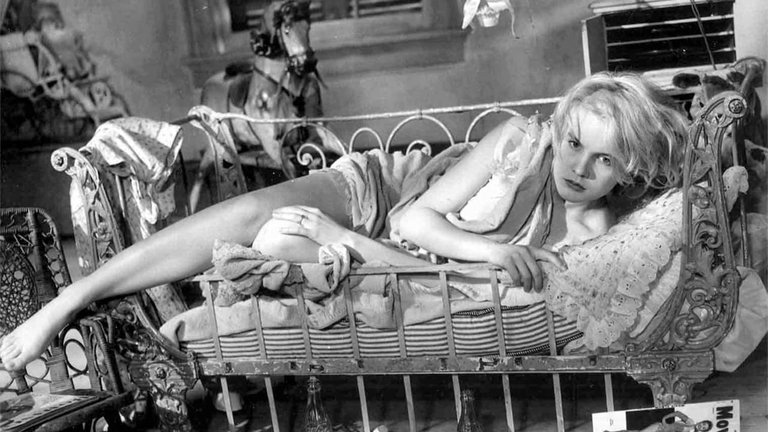Film Review: Baby Doll (1956)

Certain films earn their place in cinema history primarily by exemplifying how societal norms can evolve over time and what is considered acceptable on the silver screen. Such films can attain this significant reputation even when created by esteemed and highly respected directors. One such director was Elia Kazan, whose 1956 drama Baby Doll emerged as one of the most controversial films of 1950s Hollywood.
The screenplay for Baby Doll was written by the renowned playwright Tennessee Williams, who adapted two of his one-act plays: 27 Wagons Full of Cotton and The Long Stay Cut Short, or Unsatisfactory Supper. Set against the backdrop of the Mississippi Delta, the narrative follows Archie Lee Meighan (played by Karl Malden), a middle-aged cotton gin owner grappling with significant business and personal challenges. Archie Lee's enterprise is failing, primarily due to the superior machinery of his Sicilian American competitor, Silva Vaccaro (played by Eli Wallach). This rivalry leaves Archie Lee on the brink of financial ruin, with the once-grand house he purchased for his 19-year-old wife, Baby Doll (played by Carroll Baker), now in a state of disrepair. Compounding his frustrations, Archie Lee has made a pact with Baby Doll’s deceased father that their marriage will remain unconsummated until she turns 20, a milestone that is just two days away. In a desperate act, Archie Lee sets fire to Silva’s cotton gin, an act of arson that Silva suspects but cannot definitively prove. Silva, seeking revenge, visits Archie Lee's estate under false pretences, attempting to seduce Baby Doll while Archie Lee is away.
From today’s perspective, Baby Doll is a good film, but it hardly qualifies as a classic. Elia Kazan, known for his exceptional body of work, directs Baby Doll with a keen eye for detail and atmosphere. The film benefits from the striking black-and-white cinematography of Boris Kaufman, which captures the oppressive heat and decay of the Mississippi setting. The locations, filmed in Benoit, Mississippi, serve as a poignant backdrop, with the local African American population, still affected by institutional racial segregation, appearing as extras. The jazz score composed by Kenyon Hopkins adds a layer of charm to the film, although it remains underutilised.
The cast of Baby Doll, as with many of Kazan’s films, stands out as one of its strongest attributes. Kazan frequently relied on alumni from the Actors Studio, and this film is no exception. Carroll Baker delivers an impressive performance in her first leading role, portraying a complex character who oscillates between childlike naivety and shrewd sexual manipulation. Baker's ability to embody this duality adds depth to Baby Doll, making her more than just a passive object of desire. Eli Wallach, in his first film role, effectively elicits sympathy for Silva, a character whose morally ambiguous actions are portrayed with a certain charm. Wallach's performance highlights the complexities of human nature, making Silva a compelling antagonist. Conversely, Karl Malden's portrayal of Archie Lee veers into the realm of caricature, as he often hams it up, rendering Archie Lee’s descent into madness almost cartoonish.
One of the main problems with Baby Doll is its script, which is based on two different plays fused into one. This fusion leads to a relatively slow-moving plot that stretches across almost two hours of running time. Some scenes also give away too much of the film's stage origins, which Kazan attempts to hide by infusing Southern Gothic motifs with commentary on economic issues and racial politics in 1950s South. Unfortunately, these segments do not add much to the overall narrative.
What made Baby Doll stand out was Kazan's decision to make it mildly erotic, particularly through opening scenes featuring Carroll Baker in nightwear sucking her thumb, and a later scene where Silva seduces Baby Doll in an implicit but intimate manner that leaves the audience to imagine some improper touching outside the frame. These scenes, which would later inspire the "baby doll dress" trend in fashion, managed to pass the censorship standards of the Hays Office, led by newly appointed Geoffrey Shurlock. However, this was not the case with the influential Catholic Church and its Legion of Decency, which condemned the film as immoral and organised boycotts that contributed to its box office failure.
The backlash against the Church's condemnation led critics and the liberal intelligentsia to champion the film as a way to support freedom of expression, and also contributed to Kazan winning a Golden Globe for Best Director. In a very short time, the old censorship standards of Classic Hollywood collapsed, and Baby Doll soon began to look very tame and demure in comparison to what the audience could have seen on film or even television. Many years later, Eli Wallach publicly asked what was so special about the 1956 film.
Baby Doll deserves recommendation as a good piece of cinema, but its importance lies mainly in being a marker of when standards of Hollywood censorship began to shift.
RATING: 6/10 (++)
Blog in Croatian https://draxblog.com
Blog in English https://draxreview.wordpress.com/
InLeo blog https://inleo.io/@drax.leo
Hiveonboard: https://hiveonboard.com?ref=drax
Rising Star game: https://www.risingstargame.com?referrer=drax
1Inch: https://1inch.exchange/#/r/0x83823d8CCB74F828148258BB4457642124b1328e
BTC donations: 1EWxiMiP6iiG9rger3NuUSd6HByaxQWafG
ETH donations: 0xB305F144323b99e6f8b1d66f5D7DE78B498C32A7
BCH donations: qpvxw0jax79lhmvlgcldkzpqanf03r9cjv8y6gtmk9